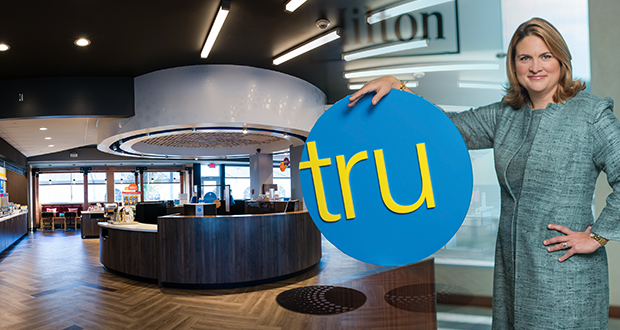
As the fastest growing hotel brand in lodging history, Hilton’s Tru has definitely garnered a lot of industry attention. LODGING caught up with Alexandra Jaritz, Hilton SVP and head of the Tru brand, at this year’s Hunter Hotel Investment Conference to talk about how Tru has evolved over the past six months and what technological innovations guests can expect from the brand in the near future.
We last spoke about six months ago. What’s changed for Tru since then?
Lots of exciting things. We have 16 hotels open now, and we’re going to have another 50 or so open by the end of the year. Now that we have open properties, we’re gathering more and more guest and owner feedback in real time. We’re seeing that we got a lot of the details right out of the gate, which is always a nice thing, but nothing is perfect, so we have continued to innovate and optimize our position.
We are also launching prototype 2.0 this spring. Our intention with 2.0 is to lower construction costs, give our guests more storage space, and optimize the work area in the guestrooms. We also found a way to activate the lobby space more than we have in the past.
It’s great to be in this tweaking and optimizing phase, and we couldn’t be happier with where we are. We have 470 deals in various stages of our development process and we’re hoping to have over 300 open by 2020.
That’s fast!
It is really fast. It’s fast and furious!
Does Tru have any innovations on the horizon?
Right now we’re pilot testing a program that will give guests the ability to preset their travel preferences before arriving at our hotels—things like temperature, entertainment, and lighting through the Hilton mobile app. Basically, by the time they check in, their preferences will be live in the room.
How are you ensuring that personalization doesn’t go too far and become creepy?
First, we give our guests the ability to opt out. If they do not want to share preferences, we make it very seamless, very easy for them to say, “I don’t want you to have any of this information.” It’s all about choice and control. Additionally, we don’t track our guests’ behavior—in their rooms or prior to check in. All we know is this person wants the temperature at this level when she goes to sleep, she likes her lighting a certain way, and her favorite shows and movies are on Netflix. We’re not going to track behavior and that information is anatomized.
How are you communicating that to guests?
That’s something we’re still working on, frankly. That’s one of the reasons we’re still in pilot testing. Right now, we’re very focused on the functionality. Security is our number one priority because if we lose our guests’ trust, we may never earn it back. We very aware and working very diligently on that. Especially because there are different expectations at a global level. That’s part of the complexity of rolling something like this out. But we’re very confident we can and we will in a way that people are comfortable with.
Also, if guests aren’t seeing it as an added benefit, then it’s not worth it. But so far, the test that we’ve seen are coming back and they’re basically saying, “Can you do this faster please? And boy, I want something like this in my house!”
How will this program impact staff at Tru properties?
I think the important thing is that we continue to approach technology as a means to enable better service. We don’t see it as a way of reducing the roles of team members. In fact, the way we see it is our team members are free to spend time to deliver more meaningful guest experiences, to go the extra mile and to engage with a guest. It allows us to automate the processes that can be automated so our team members can deliver even better service.
Is there anything in the industry keeping you up at night?
The industry in general is facing rising labor costs, especially in the area of housekeeping. We’re seeing just across the enterprise and in the industry that the costs are increasing on that front. This is very much on our radar because we are always looking to identify pain points at our hotels. Rising labor costs is something that deeply impacts our owners and we want to help control those costs.
What do you think the rest of 2018 will hold for Tru?
Overall, I have a very, very optimistic view for 2018. I think for Tru specifically, we’re going to continue to be laser-focused on the needs of our brand. Hilton has 14 brands in its portfolio, and they all have different needs. Our needs include acquiring new customers and supporting the owners coming into the system who are new to Hilton. These initiatives are really exciting for our brand, and we really think of them as opportunities for further growth.











